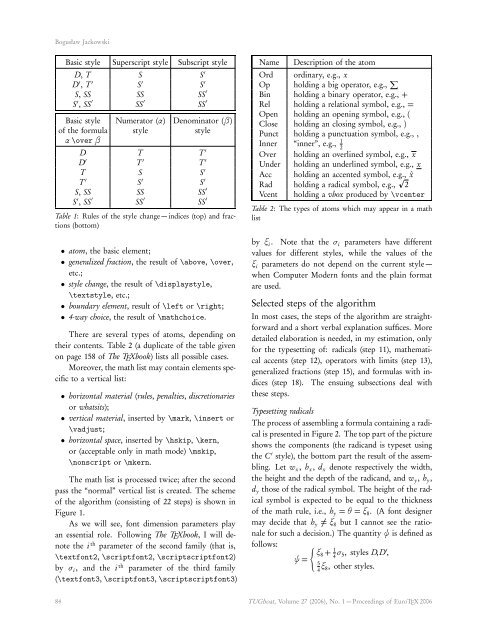Appendix G illuminated - TUG
Appendix G illuminated - TUG
Appendix G illuminated - TUG
Create successful ePaper yourself
Turn your PDF publications into a flip-book with our unique Google optimized e-Paper software.
Bogusław Jackowski<br />
Basic style Superscript style Subscript style<br />
D, T S S ′<br />
D ′ , T ′ S ′ S ′<br />
S, SS SS SS ′<br />
S ′ , SS ′ SS ′ SS ′<br />
Basic style Numerator (α) Denominator (β)<br />
of the formula style style<br />
α \over β<br />
D T T ′<br />
D ′ T ′ T ′<br />
T S S ′<br />
T ′ S ′ S ′<br />
S, SS SS SS ′<br />
S ′ , SS ′ SS ′ SS ′<br />
Table 1: Rules of the style change — indices (top) and fractions<br />
(bottom)<br />
• atom, the basic element;<br />
• generalized fraction, the result of \above, \over,<br />
etc.;<br />
• style change, the result of \displaystyle,<br />
\textstyle, etc.;<br />
• boundary element, result of \left or \right;<br />
• 4-way choice, the result of \mathchoice.<br />
There are several types of atoms, depending on<br />
their contents. Table 2 (a duplicate of the table given<br />
on page 158 of The TEXbook) lists all possible cases.<br />
Moreover, the math list may contain elements specific<br />
to a vertical list:<br />
• horizontal material (rules, penalties, discretionaries<br />
or whatsits);<br />
• vertical material, inserted by \mark, \insert or<br />
\vadjust;<br />
• horizontal space, inserted by \hskip, \kern,<br />
or (acceptable only in math mode) \mskip,<br />
\nonscript or \mkern.<br />
The math list is processed twice; after the second<br />
pass the “normal” vertical list is created. The scheme<br />
of the algorithm (consisting of 22 steps) is shown in<br />
Figure 1.<br />
As we will see, font dimension parameters play<br />
an essential role. Following The TEXbook, I will denote<br />
the i th parameter of the second family (that is,<br />
\textfont2, \scriptfont2, \scriptscriptfont2)<br />
by σ i , and the i th parameter of the third family<br />
(\textfont3, \scriptfont3, \scriptscriptfont3)<br />
Name<br />
Description of the atom<br />
Ord ordinary, e.g., x<br />
Op holding a big operator, e.g., ∑<br />
Bin holding a binary operator, e.g., +<br />
Rel holding a relational symbol, e.g., =<br />
Open holding an opening symbol, e.g., (<br />
Close holding an closing symbol, e.g., )<br />
Punct holding a punctuation symbol, e.g., ,<br />
Inner “inner”, e.g., 1 2<br />
Over holding an overlined symbol, e.g., x<br />
Under holding an underlined symbol, e.g., x<br />
Acc holding an accented symbol, e.g., ˆx<br />
Rad holding a radical symbol, e.g., 2<br />
Vcent holding a vbox produced by \vcenter<br />
Table 2: The types of atoms which may appear in a math<br />
list<br />
by ξ i . Note that the σ i parameters have different<br />
values for different styles, while the values of the<br />
ξ i parameters do not depend on the current style —<br />
when Computer Modern fonts and the plain format<br />
are used.<br />
Selected steps of the algorithm<br />
In most cases, the steps of the algorithm are straightforward<br />
and a short verbal explanation suffices. More<br />
detailed elaboration is needed, in my estimation, only<br />
for the typesetting of: radicals (step 11), mathematical<br />
accents (step 12), operators with limits (step 13),<br />
generalized fractions (step 15), and formulas with indices<br />
(step 18). The ensuing subsections deal with<br />
these steps.<br />
Typesetting radicals<br />
The process of assembling a formula containing a radical<br />
is presented in Figure 2. The top part of the picture<br />
shows the components (the radicand is typeset using<br />
the C ′ style), the bottom part the result of the assembling.<br />
Let w x , h x , d x denote respectively the width,<br />
the height and the depth of the radicand, and w y , h y ,<br />
d y those of the radical symbol. The height of the radical<br />
symbol is expected to be equal to the thickness<br />
of the math rule, i.e., h y = θ = ξ 8 . (A font designer<br />
may decide that h y ≠ ξ 8 but I cannot see the rationale<br />
for such a decision.) The quantity ψ is defined as<br />
follows: <br />
ξ8 + 1 4 σ 5, styles D,D ′ ,<br />
ψ =<br />
5<br />
4 ξ 8, other styles.<br />
84 <strong>TUG</strong>boat, Volume 27 (2006), No. 1 — Proceedings of EuroTEX 2006

















